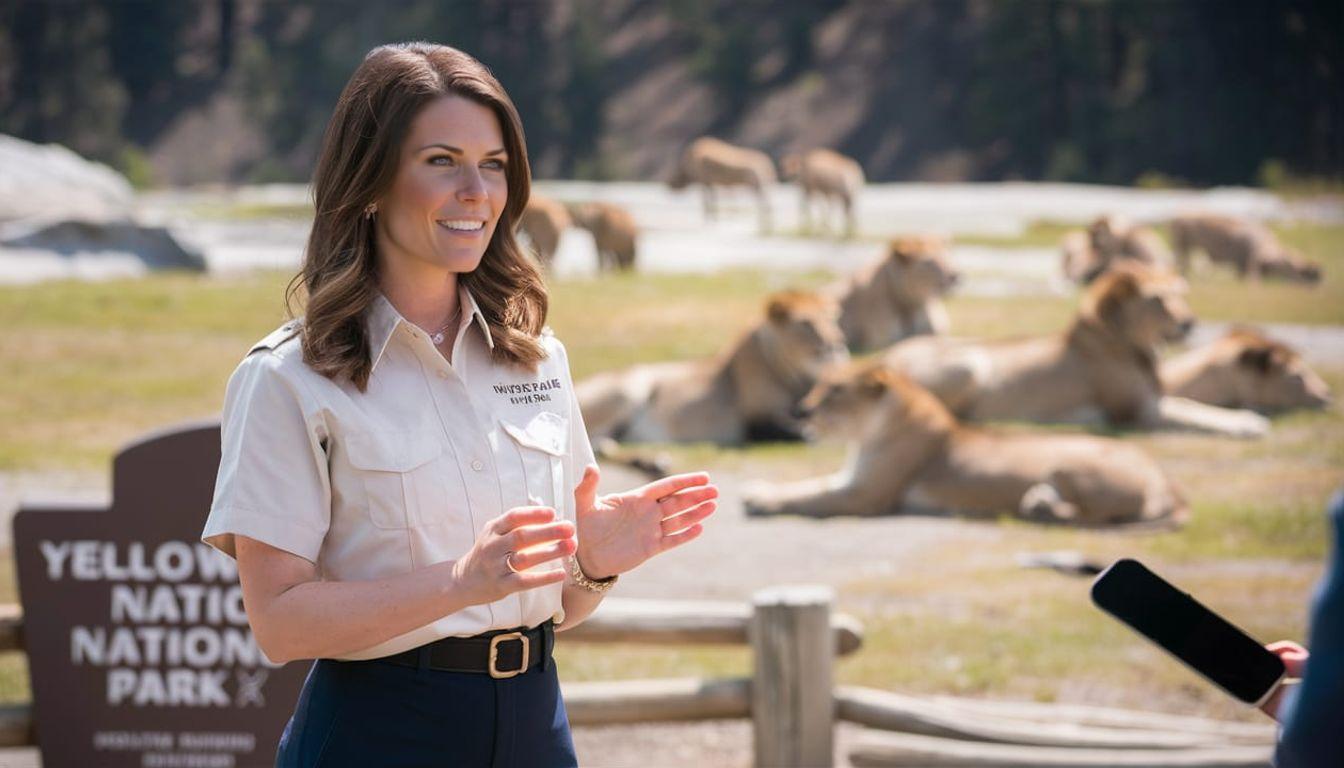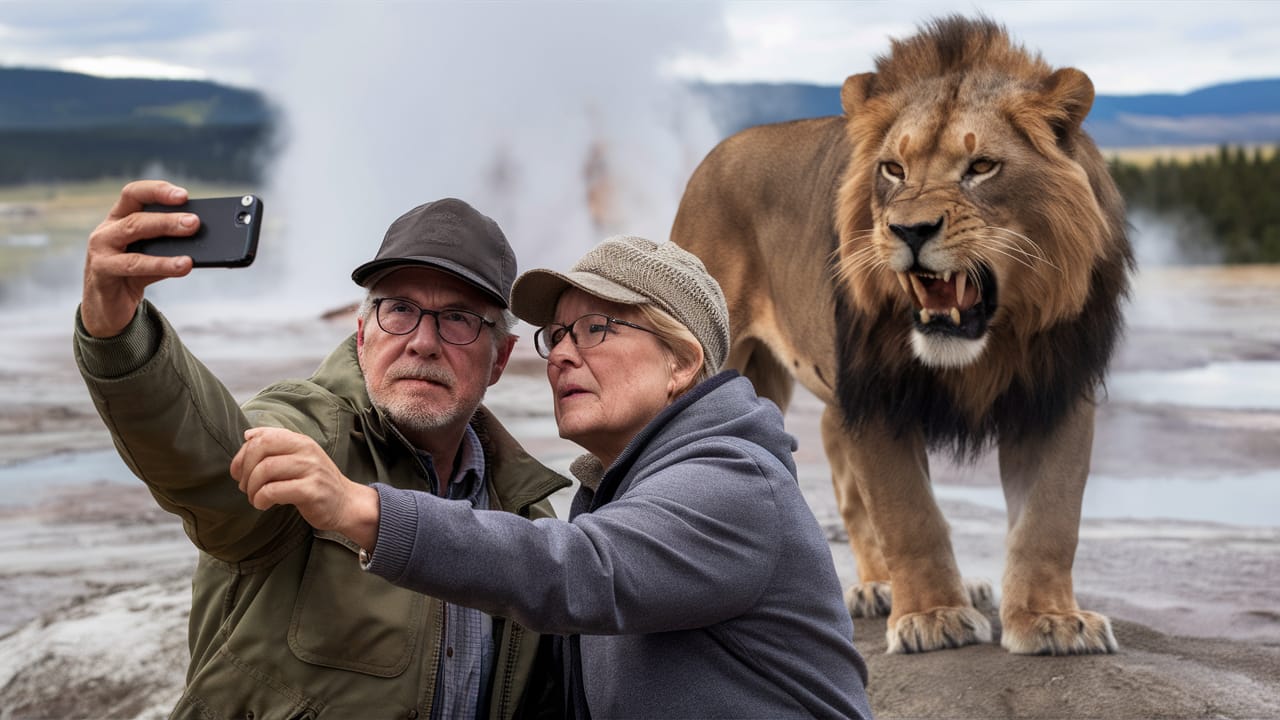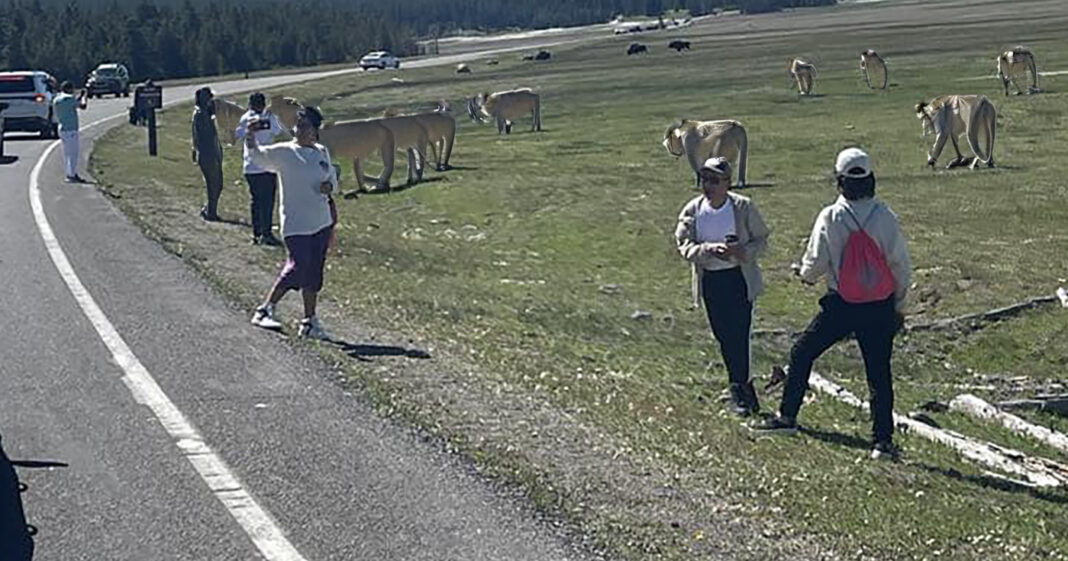West Yellowstone, ID — In a move that has left park rangers and wildlife experts scratching their heads, Yellowstone National Park has introduced a new feature: the “Lion Encounter.” This latest addition to the park is designed to cater to the ever-growing number of tourists seeking the perfect Instagram photo, regardless of the mortal peril involved.
The scene is surreal and alarmingly familiar: a line of cars parked haphazardly along the main road into Yellowstone, with tourists casually milling about, their phones poised to capture the perfect shot of a pride of lions. Yes, you read that right—lions. The iconic predators, typically native to the African savannah, now roam freely in America’s first national park, much to visiting families’ delight and apparent obliviousness.
Bethany Millbright, spokeswoman for the vacation destination company BrightStar Adventures Limited, which has partnered with the National Park Service for this venture, explained the rationale during a recent conference call.
“We noticed an increasing demand for more thrilling wildlife encounters. The bison and elk just weren’t cutting it anymore. People wanted something with a bit more bite—literally.”

Introducing lions to Yellowstone is part of a broader strategy to make the park more “interactive” and “social media-friendly.” Park officials, facing budget cuts and a surge in visitor numbers, saw the move as a win-win.
“This is about enhancing the visitor experience and making Yellowstone relevant in the age of TikTok and Instagram,” continued Millbright. The audacious decision to introduce African lions to Yellowstone was a groundbreaking effort to “increase biodiversity and enhance the park’s ecological tapestry.”
According to Millbright, this initiative is part of a larger experimental program to create a more dynamic and diverse wildlife environment.
“While Yellowstone is home to mountain lions, the introduction of African lions aims to create an unprecedented cross-continental ecological fusion,” Millbright stated during a press conference. “By blending species from different continents, we’re not only offering a unique experience for visitors but also pushing the boundaries of conservation science.” This bold move, she asserts, will help Yellowstone remain at the forefront of global wildlife innovation and attract even more adventurous tourists eager to witness this unique ecological experiment.
Of course, such a daring initiative comes with its critics. Wildlife experts and seasoned park rangers have voiced serious concerns about the safety implications of unleashing the pride of apex predators in a park that millions visit annually. Yet, their warnings seem to fall on deaf ears, drowned out by the clicking of camera shutters and the excited chatter of tourists eager to boast about their close encounter with a lion.
“This is natural selection in action,” remarked Dr. Harold Thompson, a wildlife biologist and longtime critic of Yellowstone’s recent ventures into extreme tourism. “We’ve created a society where people feel invincible behind their smartphone screens. They forget that nature is not a curated, filter-friendly experience. It’s wild, unpredictable, and, yes, dangerous.”

The National Park Service has attempted to mitigate the risks by requiring all participants in the Lion Encounter to sign a waiver. The document, which absolves both BrightStar and the Park Service of any liability in the event of an attack, is a stark reminder of the potential consequences. Yet, it appears the thrill of a once-in-a-lifetime selfie outweighs any such concerns.
Marshall McLuhan once warned of the numbing effect of media on the human psyche, a prophecy that seems to manifest itself daily on the plains of Yellowstone. The safeties of modern life have lulled people into a false sense of security, eroding their instinctual fears. The result is a generation of tourists who think nothing of stepping out of their cars to snap a photo of a 500-pound carnivore.
Standing on the roadside, Samantha and Mark Johnson from Des Moines, Iowa, epitomize this new breed of adventurers.
“It’s amazing!” Samantha gushes as her husband fumbles with their camera. “We saw it on Instagram and just had to come. The lions are so majestic up close. It’s like being in a real-life nature documentary.”
As the lions stalk through the grass, seemingly indifferent to the throng of spectators, one can’t help but marvel at the scene. It’s a bizarre blend of wildlife and spectacle, a testament to humanity’s insatiable appetite for new experiences and the lengths we’re willing to go to document them.
So, the next time you visit Yellowstone, remember to keep your distance from the wildlife—unless, of course, there’s a lion. In that case, ensure your phone is fully charged, and your Instagram story is ready to capture the moment. After all, as Millbright aptly puts it, “What’s a little danger when you’re making memories?”






